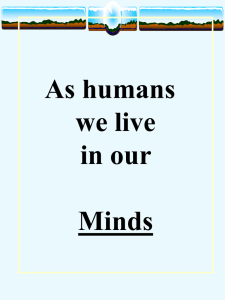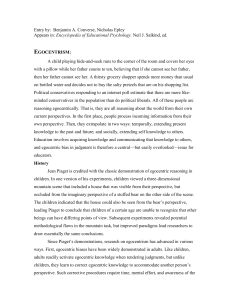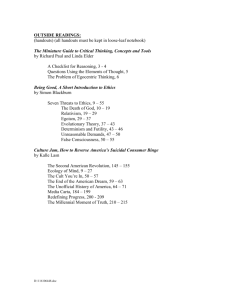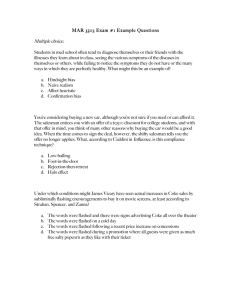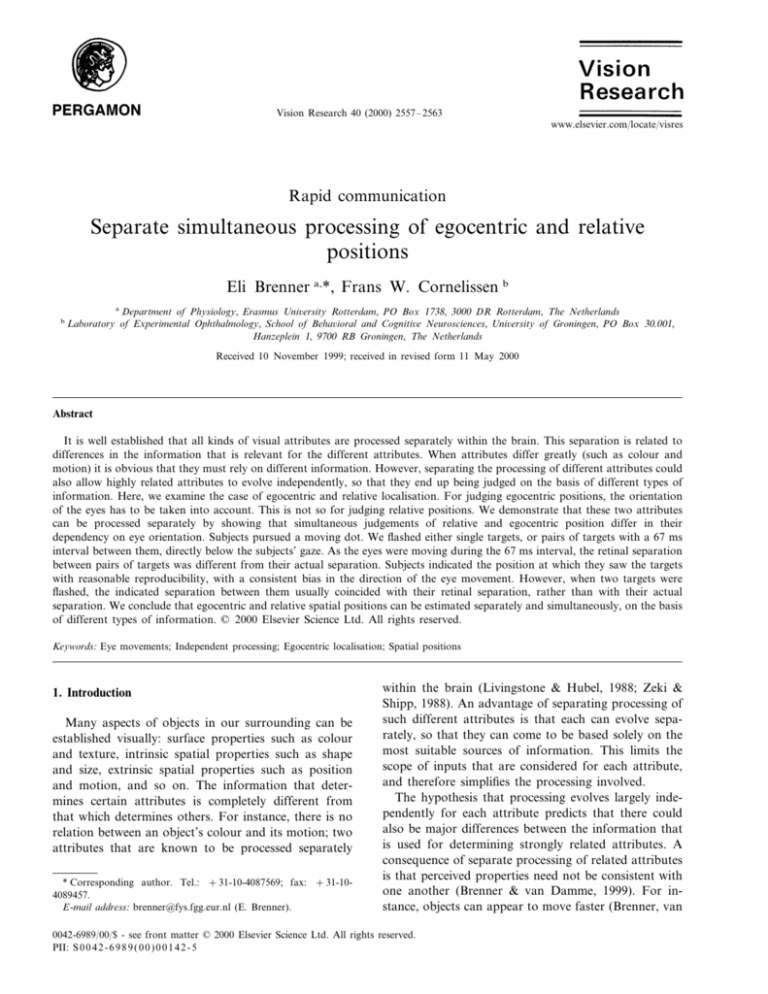
Vision Research 40 (2000) 2557 – 2563
www.elsevier.com/locate/visres
Rapid communication
Separate simultaneous processing of egocentric and relative
positions
Eli Brenner a,*, Frans W. Cornelissen b
b
a
Department of Physiology, Erasmus Uni6ersity Rotterdam, PO Box 1738, 3000 DR Rotterdam, The Netherlands
Laboratory of Experimental Ophthalmology, School of Beha6ioral and Cogniti6e Neurosciences, Uni6ersity of Groningen, PO Box 30.001,
Hanzeplein 1, 9700 RB Groningen, The Netherlands
Received 10 November 1999; received in revised form 11 May 2000
Abstract
It is well established that all kinds of visual attributes are processed separately within the brain. This separation is related to
differences in the information that is relevant for the different attributes. When attributes differ greatly (such as colour and
motion) it is obvious that they must rely on different information. However, separating the processing of different attributes could
also allow highly related attributes to evolve independently, so that they end up being judged on the basis of different types of
information. Here, we examine the case of egocentric and relative localisation. For judging egocentric positions, the orientation
of the eyes has to be taken into account. This is not so for judging relative positions. We demonstrate that these two attributes
can be processed separately by showing that simultaneous judgements of relative and egocentric position differ in their
dependency on eye orientation. Subjects pursued a moving dot. We flashed either single targets, or pairs of targets with a 67 ms
interval between them, directly below the subjects’ gaze. As the eyes were moving during the 67 ms interval, the retinal separation
between pairs of targets was different from their actual separation. Subjects indicated the position at which they saw the targets
with reasonable reproducibility, with a consistent bias in the direction of the eye movement. However, when two targets were
flashed, the indicated separation between them usually coincided with their retinal separation, rather than with their actual
separation. We conclude that egocentric and relative spatial positions can be estimated separately and simultaneously, on the basis
of different types of information. © 2000 Elsevier Science Ltd. All rights reserved.
Keywords: Eye movements; Independent processing; Egocentric localisation; Spatial positions
1. Introduction
Many aspects of objects in our surrounding can be
established visually: surface properties such as colour
and texture, intrinsic spatial properties such as shape
and size, extrinsic spatial properties such as position
and motion, and so on. The information that determines certain attributes is completely different from
that which determines others. For instance, there is no
relation between an object’s colour and its motion; two
attributes that are known to be processed separately
* Corresponding author. Tel.: +31-10-4087569; fax: + 31-104089457.
E-mail address: brenner@fys.fgg.eur.nl (E. Brenner).
within the brain (Livingstone & Hubel, 1988; Zeki &
Shipp, 1988). An advantage of separating processing of
such different attributes is that each can evolve separately, so that they can come to be based solely on the
most suitable sources of information. This limits the
scope of inputs that are considered for each attribute,
and therefore simplifies the processing involved.
The hypothesis that processing evolves largely independently for each attribute predicts that there could
also be major differences between the information that
is used for determining strongly related attributes. A
consequence of separate processing of related attributes
is that perceived properties need not be consistent with
one another (Brenner & van Damme, 1999). For instance, objects can appear to move faster (Brenner, van
0042-6989/00/$ - see front matter © 2000 Elsevier Science Ltd. All rights reserved.
PII: S 0 0 4 2 - 6 9 8 9 ( 0 0 ) 0 0 1 4 2 - 5
2558
E. Brenner, F.W. Cornelissen / Vision Research 40 (2000) 2557–2563
den Berg & van Damme, 1996) or further (Abrams &
Landgraf, 1990) than one would predict from the perceived change in position, or to be longer than one
would predict from the perceived positions of their ends
(Mack, Heuer, Villardi & Chambers, 1985). We here
examine egocentric and relative localisation. Egocentric
and relative positions are so closely related that it is not
even evident that they could be separate attributes.
However, we predict that they should be, because there
are clear advantages of processing them independently.
Egocentric localisation is essential for manipulating
objects. For instance, in order to reach out for an
object we have to track where it is relative to ourselves.
This is necessary to ensure that we move our hand in
the appropriate direction. To obtain such egocentric
information it is not enough to consider the retinal
position of the object’s image. The orientation of the
eyes also has to be taken into account.
For many other tasks, it is enough to know the
relative positions of structures of interest. Such information may help establish permanent relationships (e.g.
shapes). Knowing a target’s position relative to the
simultaneously visible hand could even help guide the
hand just before contact. Relative positions could be
judged by combining egocentric positions. Since the
same eye orientation signal presumably contributes to
all egocentric positions, misjudging the eye orientation
will influence the positions of all simultaneously visible
structures in the same way, so that relative positions
could be judged much more accurately than are the
individual egocentric positions. Alternatively, however,
relative retinal positions could be used directly. This is
a fundamentally different mechanism, because in this
case the retinal separations are determined before eye
orientations are considered, and the latter only serve to
help interpret these separations (e.g. to convert them to
actual distances in space; Brenner & van Damme,
1999).
For simultaneously visible structures both mechanisms predict the same performance: more accurate
relative positions than egocentric positions. However, if
the structures are not visible simultaneously, and eye
orientation changes between presentations, the hypothesis that egocentric positions are combined predicts
correct average performance (though more variable because the eye orientation signal is no longer the same
for both structures), whereas the hypothesis that relative retinal positions are used predicts dramatic systematic errors.
In the present study we examine whether relative
positions are determined independently of the perceived
egocentric positions. We do so by presenting targets
sequentially while the subjects pursue a moving dot
with their eyes. We find that subjects indicate the
position at which they saw a target with reasonable
reproducibility, with a consistent bias in the direction of
the eye movement. When two targets are presented
briefly after one another, the perceived separation between them usually coincides with their retinal separation, rather than their actual separation.
2. Materials and methods
Subjects sat with their chin on a chin rest, 57 cm
from a large screen (38.0× 28.5 cm; 640× 480 pixels;
120 Hz). The background on the screen was grey (25
cd/m2) with a faint random texture (10% lighter and
darker grey dots). The room was dark except for indirect illumination by the image on the screen. Eye
movements were recorded with an SMI EyeLink Gazetracker (SensoMotoric Instruments GmbH, Teltow,
Germany). Stimuli were produced using some of the
software routines from the ‘VideoToolbox’ (Pelli, 1997).
2.1. The stimuli
The subjects were instructed to pursue a yellow dot
(0.25° diameter; 69 cd/m2) as it moved rightward at a
velocity of 13 deg/s across the screen. This dot always
started 15° to the left of the centre of the screen. After
between 750 and 1250 ms of pursuit, a target was
visible during one frame. This target was either a 2.25°
long, 0.12° wide vertical white (75 cd/m2) line, or a
0.12° wide, 0.75° diameter white ring. On some trials, a
second target, always of the other kind, was presented
67 ms (eight frames) later. The targets were always
presented exactly below the subjects’ gaze. The centre
of the target was 1.5° below the dot, but aligned
horizontally with the eye rather than with the dot.
Thus, the targets were presented at well-defined positions on the retina, but their positions on the screen
depended on the gain of pursuit during that trial. Eye
movements were recorded at 250 Hz. The delay between sampling an eye movement and this information
being incorporated in the image was about 20 ms. This
delay was not considered when presenting the targets,
so the latter were always presented about quarter of a
degree to the left of the momentary direction of gaze.
The high contrast and considerable size of the targets
made them very easy to see at the eccentricities at
which they were presented (despite the short duration).
There were eight conditions. Two with single targets:
either a line or a circle. Two in which the two targets
were superimposed on the retina: either the line or the
circle was presented first. Two in which the second
target was presented 0.346° to the right of where it
would have to be presented for the two to be superimposed on the retina: again with either target first. And
two in which the second target was presented 0.346° to
the left of that position.
E. Brenner, F.W. Cornelissen / Vision Research 40 (2000) 2557–2563
2.2. The settings
After each stimulus presentation subjects were required to make their settings. They did so by moving
the computer’s mouse. If a single target was presented,
the same target appeared at a random horizontal position and the same height as the original target. The
target was now continuously visible, and moving the
mouse horizontally moved it laterally across the screen.
Subjects had to indicate where the original target had
been presented by moving the new target to that position and pressing the button on the mouse to indicate
that they had done so. If two targets had been presented, subjects first had to set the circle in the manner
just described, and then to do the same for the line.
2.3. Procedure
Each session started with a nine-point calibration of
the eye movement recordings. After calibration the
various conditions were presented in random order.
Subjects never knew whether a second target would be
presented. The single targets were each presented 20
times, giving a total of 40 presentations per subject. The
double targets were presented five times for each retinal
2559
offset and order in which the two targets were presented, giving a total of 30 presentations per subject.
Eye movements were recorded for later analysis. Half
way through the session, the calibration was validated.
2.4. Eye mo6ements
During post-hoc analysis of the eye movement traces,
all trials were discarded in which saccades were made
between 100 ms before the first target was presented,
and 100 ms after the last one was presented. Fig. 1
shows an example of a trial that was considered adequate (A, good pursuit) and one that was not (B,
rejected). Only the settings from the former kind of
trials were used in the further analysis of the results.
Table 1 shows the percentage of trials on which there
were no saccades close to the time of stimulus presentation, as well as the gain of ocular pursuit during the
approved trials.
3. Results
On some trials, a single circle or a line was flashed at
an unpredictable moment directly below the subject’s
Fig. 1. Schematic representation of the methods. Top: examples of a trial with good pursuit (A) and one with a saccade too close to the moment
a target was presented (B). In the latter case the second target was displayed 0.346° to the right of where the subject was looking. The dot that
was to be pursued always moved at 13 deg/s. Bottom: schematic representation of the sequence of events during a trial with two targets.
2560
E. Brenner, F.W. Cornelissen / Vision Research 40 (2000) 2557–2563
Table 1
Several experimental values for the individual subjects
Subject
AB
EB
EH
FC
JH
MT
MV
TC
WB
% Trials approved
Pursuit gaina
SD set positionb single targets (°)
SD real distancec,d between targets (°)
SD set distancec between targets (°)
80
1.00
1.13
0.10
0.40
94
1.00
0.80
0.09
0.17
63
0.97
1.29
0.20
1.35
80
1.08
0.86
0.08
0.12
66
1.06
1.49
0.07
0.25
44
0.96
1.48
0.05
0.15
69
1.06
1.25
0.16
1.89
81
0.87
1.04
0.19
0.31
66
0.96
1.09
0.11
0.15
a
Mean value during the 67 ms after the (first) stimulus; approved trials only.
Measured relative to the real position.
c
Mean of the standard deviations for the distance between the circle and the line for the three offsets (none; 9 0.346).
d
The distance varies between trials as a consequence of differences in pursuit gain.
b
Fig. 2. Indicating the perceived position on the screen. Settings were pooled into 1° bins of real position, and the average real and set position
was calculated for each bin. Only values based on at least three settings are shown. Positive is to the right (in the direction of pursuit). The thin
dotted line shows what subjects should have set to obtain a perfect match. (A) Set positions for trials with single targets. Thin lines: data for
individual subjects averaged across targets. Thick lines: data for each target averaged across subjects. (B) Set positions for trials with two targets.
The positions are the averages of the two targets. Thin lines: data for individual subjects. Thick line: average across subjects.
gaze. After the trial subjects were asked to place an
identical figure at the position at which the target had
been flashed. Fig. 2A shows the mean set position as a
function of the real position of such targets. Data are
presented for individual subjects (averaged over targets;
thin lines) as well as for each kind of target (averaged
over subjects; thick lines). Subjects consistently perceived the target to be slightly further in the direction
of the eye movement than it really was. The extent to
which they did so differed between subjects.
On the rest of the trials two targets were flashed, with
an interval of 67 ms between the flashes. The first target
was identical to the single targets mentioned above. The
second target was either also flashed directly below the
subject’s gaze, thus 0.87° to the right of the first target
(if pursuit was perfect), or 0.346° further to the left or
right of this. Fig. 3 shows the set distance between the
two targets as a function of the real distance between
them. The black diagonal line indicates veridical performance. The thick grey line represents the settings one
would expect if subjects relied exclusively on retinal
information and pursued the dot perfectly. Most subjects (circles) perceived the positions of the targets
relative to each other in accordance with their retinal
separation. This was clearly not the result of some kind
of compression of perceived space (Morrone, Ross &
Burr, 1997), because the retinal separations were fully
accounted for (open circles). Two subjects, however,
appeared to be doing something completely different
(triangles). An examination of the variability in their
settings (Table 1) may give us a clue as to what they
were doing.
All the other subjects (the ones who judged relative
position on the basis of retinal separation) exhibited
much less variability (expressed as the standard deviation: SD) in their judgements of relative position than
in their judgements of the egocentric position of single
targets. Thus their judgements of relative position could
not have been based on comparing independent estimates of the positions of the two targets. (Doing so
E. Brenner, F.W. Cornelissen / Vision Research 40 (2000) 2557–2563
would have resulted in a standard deviation that is
about 1.4 times as large as that of each on its own
unless the eye orientation signals at the two moments
are not independent. We will see in the next paragraph
that they probably are independent. The standard deviation could be even larger, because controlling the
retinal stimulation introduces variability in the real
distance between targets due to variability in pursuit
gain; see Table 1).
The two subjects (EH and MV) who did not set the
relative positions in accordance with the retinal separation were very much more variable in their settings of
relative positions. In fact, their standard deviations
were close to what we would predict if they were
making two independent judgements, each in the manner that their judgements were made when only one
target was present. If this interpretation is correct, then
the eye orientation signals must be more or less independent at the two moments. These subjects presumably considered the two targets as independent
structures, and made two separate egocentric judgements (in accordance with the task).
Fig. 2B shows the average of the set positions of the
two targets as a function of the average of their real
positions, in the same manner as was done for single
targets in the left panel. Since there were fewer trials
with two targets, and the time during which subjects
were not to make saccades was longer, fewer points
contribute to this figure. However, it is evident that
Fig. 3. Set distance between targets for trials with two targets. Thin
black diagonal line: expected settings if the distance between the
targets was perceived veridically. Thick grey line segment: expected
settings if based exclusively on the retinal image (assuming perfect
pursuit, open symbols would lie at the ends and solid symbols at the
centre of this line). Arrow: real distance that the eye would cover in
67 ms if pursuit of the target moving at 13 deg/s were perfect. Solid
symbols: both targets presented directly below the subject’s gaze. If
pursuit were perfect the real distance between them would be the
value indicated by the arrow. Open symbols: second target presented
0.346° to the left or right of where the subject is looking. Circles: data
for the subjects who set the relative positions much more reliably
(smaller SD; see Table 1) than the egocentric positions of single
targets. Triangles: data for the two subjects who did not (EH and
MV; see Table 1).
2561
subjects were placing the combination of line and circle
in approximately the same manner as they had been
placing the individual components. These settings were
not more variable. The average (across subjects) of the
standard deviations of the set positions (with respect to
the real position) was 1.03°, compared with 1.16° for
single targets (see Table 1). Since subjects always first
set the circle one may expect the settings for the line to
be more variable. This was not so. When considered
independently, the average standard deviation was
0.99° for the circle and 0.98° for the line (similar to the
values when the stimuli were presented alone).
4. Discussion
It was well known that subjects can localise targets
quite accurately during smooth pursuit (Hansen, 1979).
Nevertheless, when Stoper (1967); as cited in Matin,
1986, p. 39) flashed targets while subjects were pursuing
an unrelated structure, he found that eye orientation
was not taken into consideration for determining relative positions of successively presented targets unless
the targets were separated in time by more than 700 ms.
The tendency to misperceive targets in the direction of
the eye movement has also often been reported (Mita,
Hironaka & Koike, 1950; Mitrani, Dimitrov, Yakimoff
& Mateeff, 1979; Mateeff, Yakimoff & Dimitrov, 1981;
Brenner & Smeets, 1998). Thus, none of the findings is
new. However, we demonstrate both phenomena within
single presentations. This is not trivial, because all sorts
of methodological differences between studies are
known to influence whether eye orientation is
considered.
Rock and Linnett (1993) found that subjects did
consider eye orientation when combining lines that
were presented at intervals of 250–400 ms to form a
shape. They found that subjects no longer accounted
for eye orientation on the basis of an extra-retinal
signal if there was a visual reference. In that case
subjects’ judgements were based on the positions of the
flashed targets relative to the visual reference, even
when the reference was actually moving. In our study
we had ample stable visible structures that could have
served as a reference. If subjects had judged the targets’
positions relative to these structures they would have
perceived the relative distances as presented on the
screen, which they did not. They may, however, have
judged the flashed targets’ positions relative to the
moving dot, rather than relative to each other.
To find out whether this was what subjects were
doing we had four subjects repeat the two-target part of
the experiment with three conditions (30 trials per
condition, divided into 6 sets on the basis of the order
of appearance of the targets — target or circle first —
and the retinal distance between the first and second
2562
E. Brenner, F.W. Cornelissen / Vision Research 40 (2000) 2557–2563
disposed to considering asynchronously presented parts
as separate entities. We are not claiming that subjects
are unable to combine egocentric positions to judge
relative ones. Our claim is that they can determine
relative positions directly on the basis of different information. This dichotomy is consistent with the suggestion that eye orientation is only considered at the
moment that egocentric localisation is explicitly required (Henriques, Klier, Smith, Lowy & Crawford,
1998).
5. Conclusions
Fig. 4. Influence of removing the moving dot (the target of pursuit)
near stimulus presentation. Format as in Fig. 3. Circles: moving dot
constantly visible Triangles: moving dot disappeared for 133 ms.
Squares: moving dot disappeared for 267 ms. Data of four subjects
(EB, FC, MT, TC).
target). The first condition was identical to the original
one with two targets. The second was the same except
that the moving dot disappeared when the first target
flashed, and only reappeared 67 ms after the second
flash. In the third condition the moving dot disappeared 67 ms before the first target flashed and only
reappeared 133 ms after the second one did. The average set position was 2.9° to the right of the flashed
targets when the moving dot did not disappear, 2.5° to
the right when it disappeared for 133 ms, and 2.3° when
it disappeared for 267 ms. Fig. 4 shows the set distance
between the targets as a function of the real distance in
the same format as Fig. 3. It is evident that the simultaneous presence of the moving dot is not critical.
These results support our notion that subjects judge
the relative positions of the two flashed targets from
their retinal separation. However, our conclusion would
not have been very different if we had found that
subjects used the moving dot as a reference, because in
either case they ignore the change in eye orientation
during the 67 ms between the targets. For the localisation of the targets in space, on the other hand, the
persistent bias in the direction of the eye movement
confirms that we are dealing with egocentric judgements that consider eye orientation (but do so
incorrectly).
Whether subjects report egocentric positions or relative positions appears to differ between studies, between
aspects of the task, and even between subjects. In the
present study two subjects seemed to perceive the two
targets as separate structures, whereas the rest appeared
to perceive a single structure whose shape was based on
the targets’ relative retinal positions. Similarly, Hayhoe,
Lachter and Feldman (1991) found that some subjects
needed a visible reference to reliably judge the relative
positions of targets presented across saccades, whereas
others did not. Presumably some subjects are more
We conclude that egocentric and relative spatial positions can be estimated independently, on the basis of
different types of information. Eye orientation is only
considered when evaluating egocentric positions. Thus
our results provide support for the notion that even
judgements of highly related visual attributes can be
based on more or less independent processing (Mack et
al., 1985; Abrams & Landgraf, 1990; Brenner & van
Damme, 1999). The advantage of doing so lies in the
ability to limit the information that is considered for
each judgement to the information that has proven to
be the most suitable.
References
Abrams, R. A., & Landgraf, J. Z. (1990). Differential use of distance
and location information for spatial localization. Perception &
Psychophysics, 47, 349 – 359.
Brenner, E., van den Berg, A. V., & van Damme, W. J. (1996).
Perceived motion in depth. Vision Research, 36, 699 – 706.
Brenner, E., & van Damme, W. J. M. (1999). Perceived distance,
shape and size. Vision Research, 39, 975 – 986.
Brenner, E., & Smeets, J. B. J. (1998). Using oculo-motor efference to
predict a moving target’s position. In B. Bril, A. Ledebt, G.
Dietrich, & A. Roby-Brami, Ad6ances in perception– action coupling (pp. 90 – 94). Paris: EDK.
Hansen, R. M. (1979). Spatial localization during pursuit eye movements. Vision Research, 19, 1213 – 1221.
Hayhoe, M., Lachter, J., & Feldman, J. (1991). Integration of form
across saccadic eye movements. Perception, 20, 393 – 402.
Henriques, D. Y. P., Klier, E. M., Smith, M. A., Lowy, D., &
Crawford, J. D. (1998). Gaze-centered remapping of remembered
visual space in an open-loop pointing task. The Journal of Neuroscience, 18, 1583 – 1594.
Livingstone, M., & Hubel, D. (1988). Segregation of form, color,
movement, and depth: anatomy, physiology, and perception. Science, 240, 740 – 749.
Mack, A., Heuer, F., Villardi, K., & Chambers, D. (1985). The
dissociation of position and extent in Müller – Lyer figures. Perception & Psychophysics, 37, 335 – 344.
Mateeff, S., Yakimoff, N., & Dimitrov, G. (1981). Localization of
brief visual stimuli during pursuit eye movements. Acta Psychologica, 48, 133 – 140.
Matin, L. (1986). Visual localization and eye movements. In K. R.
Boff, L. Kaufman, & J. P. Thomas, Handbook of perception and
human performance. Sensory processes and perception (ch. 20), vol.
1. New York: Wiley-Interscience.
E. Brenner, F.W. Cornelissen / Vision Research 40 (2000) 2557–2563
Mita, T., Hironaka, K., & Koike, I. (1950). The influence of
retinal adaptation and location on the ‘Empfindungszeit’.
The Tohoku Journal of Experimental Medicine, 52, 397 –
405.
Mitrani, L., Dimitrov, G., Yakimoff, N., & Mateeff, S. (1979).
Oculomotor and perceptual localization during smooth eye movements. Vision Research, 19, 609–612.
Morrone, M. C., Ross, J., & Burr, D. C. (1997). Apparent position of
visual targets during real and simulated saccadic eye movements.
The Journal of Neuroscience, 17, 7941–7953.
.
2563
Pelli, D. G. (1997). The VideoToolbox software for visual psychophysics: transforming numbers into movies. Spatial Vision, 10,
437 – 442.
Rock, I., & Linnett, C. M. (1993). Is a perceived shape based on its
retinal image? Perception, 22, 61 – 76.
Stoper, A. E. (1967). Vision during pursuit mo6ement: the role of
oculomotor information. Unpublished doctoral dissertation.
Brandeis University.
Zeki, S., & Shipp, S. (1988). The functional logic of cortical connections. Nature, 335, 311 – 317.

